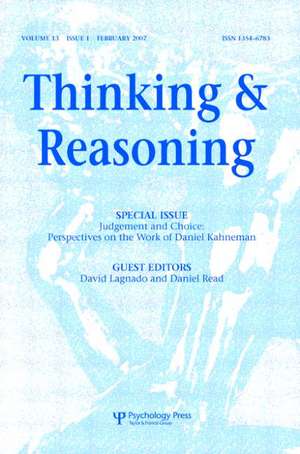Judgement and Choice: Perspectives on the Work of Daniel Kahneman: Special Issues of Thinking and Reasoning
Editat de David Lagnado, Daniel Readen Limba Engleză Paperback – mar 2007
Preț: 347.05 lei
Preț vechi: 466.33 lei
-26% Nou
Puncte Express: 521
Preț estimativ în valută:
66.41€ • 69.52$ • 54.95£
66.41€ • 69.52$ • 54.95£
Carte tipărită la comandă
Livrare economică 05-19 aprilie
Preluare comenzi: 021 569.72.76
Specificații
ISBN-13: 9781841698250
ISBN-10: 1841698253
Pagini: 82
Dimensiuni: 156 x 234 x 5 mm
Greutate: 0.14 kg
Ediția:1
Editura: Taylor & Francis
Colecția Psychology Press
Seria Special Issues of Thinking and Reasoning
Locul publicării:Oxford, United Kingdom
ISBN-10: 1841698253
Pagini: 82
Dimensiuni: 156 x 234 x 5 mm
Greutate: 0.14 kg
Ediția:1
Editura: Taylor & Francis
Colecția Psychology Press
Seria Special Issues of Thinking and Reasoning
Locul publicării:Oxford, United Kingdom
Cuprins
D. Lagnado, Perspectives on the Work of Daniel Kahneman (Editorial). N. Harvey, Use of Heuristics: Insights from Forecasting Research. J. Maule, G. Villejoubert, What lies Beneath: Reframing Framing Effects. D. Read, Experienced Utility: Utility Theory From Jeremy Bentham to Daniel Kahneman. P. Ayton, A. Pott, N. Elwakili, Affective Forecasting: Why Can’t People Predict Their Emotions? G. Loomes, (How) Can We Value Health, Safety and the Environment?
Descriere
This special issue presents ongoing research inspired by both Kahneman and Tversky. It covers many of the central themes – the heuristics and biases of judgment and prediction, framing effects, assessments and predictions of utility – that made their work so innovative.

